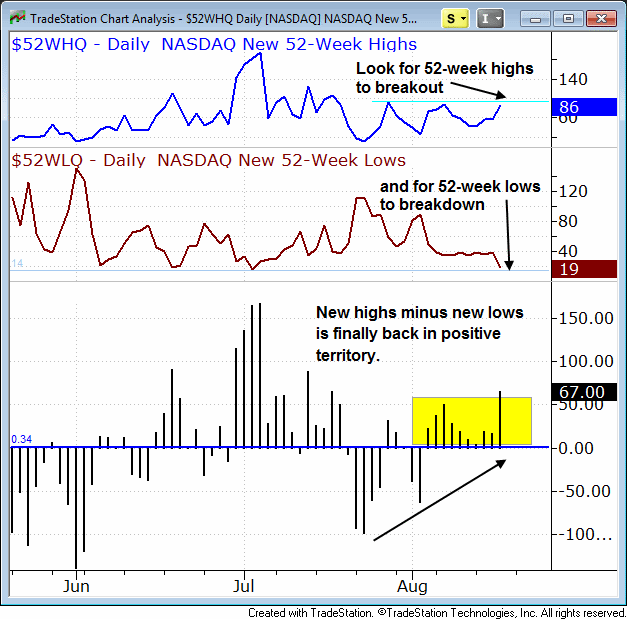Yesterday (August 16), the main stock market indexes rallied to break out above the confines of their week-long consolidation patterns. Most importantly, the bullish breakout was confirmed by increasing volume in the broad market. Total volume in the Nasdaq surged 27% above the previous day’s level, while turnover in the NYSE rose 17%. Since yesterday’s substantial gains were backed by increasing volume, both the NYSE and Nasdaq registered a bullish “accumulation day” that was indicative of institutional buying activity. Furthermore, it was positive and important that the rally was led by small-cap (Russell 2000) and mid-cap (S&P Midcap 400) growth stocks. These factors, along with a few proprietary technical signals, caused our rule-based market timing system to shift from “neutral” to “buy.” Nevertheless, until the timing model shifts from “buy” to “confirmed buy” mode, we will continue to operate conservatively and avoid using margin in our model trading portfolio. Click here to learn about the 5 different modes of our market timing model.
With stocks and ETFs pushing higher, we are now looking for market breadth to expand, which would confirm this market advance. So far, we are beginning to see improving breadth with small-cap growth stocks waking up. Another tool we use to monitor breadth is a simple chart showing the number of stocks making new 52-week highs minus the number of stocks making new 52-week lows. When the difference is firmly positive, and stays that way, it is a confirming signal of improving market breadth. The chart below shows the number of new 52-week highs on the Nasdaq, new 52-week lows on the Nasdaq, and the difference on the bottom:

On the chart above, note that the lines are going in the right direction to indicate an improving bullish trading environment. For the past three weeks, New 52-Week Highs (the blue line) has formed several “higher lows,” and is now poised to breakout above resistance of its prior “swing high.” In non-technical terms, this would simply equate to a surge in the number of stocks jumping to new 52-week highs. Since stocks and ETFs trading at new 52-week highs have no overhead supply and price resistance of prior highs to hold them down, our most profitable swing trades are frequently in stocks and ETFs trading at 52-week highs (like this $CBM trade we closed on August 15 for an 11% gain on a 4-day hold). Conversely, the New 52-week Lows (burgundy line in the middle) has been setting “lower highs,” and is now poised to break down beneath the summer lows. Overall, we are pleased with current market conditions, but would like to start seeing more powerful breakouts emerging in mass quantities in order to give us the confidence to start aggressively buying leading stocks and ETFs again.
The commentary above is derived from the August 17 issue of The Wagner Daily, our nightly stock and ETF swing trading newsletter. Subscriptions equate to less than $2 per day (with annual discount) and you can test-drive our ETF and stock picking service risk-free for the first 30 days.
